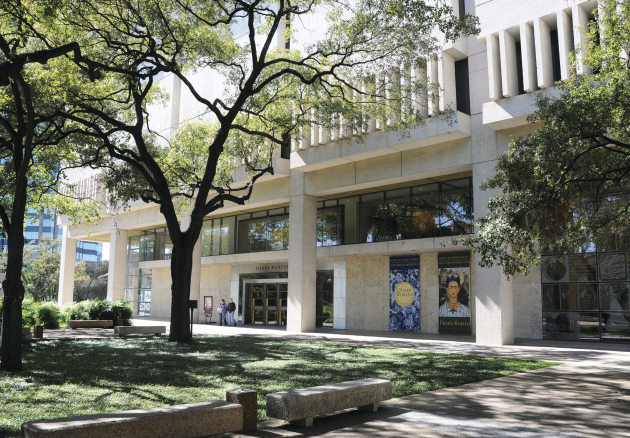Discovering Lost Literary Works on the Forty Acres

Inside UT’s historic Gregory Gym is a modern-looking annex that was surely not part of the campus institution’s original floor plan in 1930. Or at the very least, certainly not with its current purpose in mind: to house neatly stacked rows of floor-to-ceiling bright white Amazon lockers. The futuristic package delivery room is the epitome of modern convenience. On a recent Tuesday morning, waiting for my coffee, I ordered a novel from my phone. Within a few hours, Amazon emailed me—“Your stuff is ready”—with a unique code to enter onto the locker’s touchscreen. The book was in my hands in time for me to dive into it over a late lunch.
In a world where 32.8 million books are only ever a click—and rarely more than a few hours—away, it can be hard to wrap our heads around the idea that not every published word is instantly accessible. It’s even more difficult to comprehend the concept of a lost work. And yet this summer, hidden pieces from two of America’s greatest authors made national news after being unearthed in UT archives. At the Harry Ransom Center, just under a half mile away from the Amazon lockers, researchers discovered a never-before-published John Steinbeck short story, and a powerful lost work from Langston Hughes examining race and the chain gangs of the South.
The Steinbeck story—“The Amiable Fleas,” a humorous narrative about a Parisian chef—is a departure from his more well-known, staid works like The Grapes of Wrath. Written in English and translated to French for the Parisian newspaper Le Figaro, the fictional tale had never before been published in English, until Andrew F. Gulli, managing editor of the literary quarterly The Strand Magazine, sent a researcher to pore through the 12 boxes that comprise the Ransom Center’s John Steinbeck Collection, a treasure trove that includes articles written during his European travels, novel drafts, letters to and from the author, and even his war correspondent identity card.
“I read this one and I was like, ‘Oh my god,’” Gulli told The New York Times. “There was something universal about it with the gourmet, the cat, the family conflict, and the tension.”
Gulli had a sense—or at least a wish—that his researcher might find something of note; it’s not the first time The Strand Magazine has run unknown pieces from literary legends, including “A Room on the Garden Side,” an Ernest Hemingway short story written in 1956 and published for the first time in the summer of 2018, and another Steinbeck story in 2014. But Steven Hoelscher, chair of UT’s Department of American Studies, was searching for something else entirely when he discovered Hughes’ “Foreword from Life,” a lost essay from one of the most influential figures of the Harlem Renaissance.
Hoelscher is also faculty curator of photography at the Ransom Center, and was working on a project about the investigative journalist John L. Spivak when he stumbled across a manuscript with Hughes’ name. Right away, Hoelscher knew he had found something special. But he had to get to the bottom of what it was and why it was buried in the archives of Spivak, who spent the 1920s and ’30s covering social injustice.
“I was thinking, ‘Spivak, are you stupid?’” Hoelscher laughs. “‘Do you not know what you had in your archive?’ But of course he’s not stupid. It just made no sense.”
Spivak’s archive is full of photographs he took documenting African-American convicts in rural Georgia in the early 1930s, and the abuse they endured as prisoners on chain gangs. Today scholars consider the forced labor system, a common punishment in Georgia from the 1860s through the 1940s, “a form of slavery by another name,” Hoelscher says.
In 1932, Spivak published a novel based on his reporting on the atrocities and torture. The Hughes essay, found among Spivak’s drafts of his novel, writing notes, and correspondence, is a powerful account of his encounter with an escaped chain gang prisoner while traveling through Georgia with an unnamed friend. It reads like a foreword to Spivak’s novel, and yet Hoelscher couldn’t find it in any of the published versions.
So he turned to a secondary source: The Life of Langston Hughes: Volume I, written by Arnold Rampersad, a professor emeritus at Stanford. As he read, Hoelscher started to piece a few things together. Hughes was traveling in the South in 1927 when he ran into another central figure of the Harlem Renaissance, the eminent writer Zora Neale Hurston, in Mobile, Alabama. The two decided to drive back to New York City together, and trekked Northeast in Hurston’s small Nash coupe, “Sassy Susie.” Could it be that the unnamed friend in Hughes’ essay was Hurston?
Hoelscher sent “Foreword to Life,” to Rampersad and asked what he thought of his theory. “I’ve never seen this,” Hughes’ authoritative biographer responded right away.
“He was so gracious,” Hoelscher says. “He said that for Langston Hughes questions, he stops everything in his tracks, and we had several days of really wonderful correspondence.”
Rampersad agreed with Hoelscher that it was likely written in 1927, and urged him to publish the essay, an invaluable glimpse not only into Hughes’ own experience of driving through the Jim Crow South, but also one of the very rare stories from the time that includes a convict’s own words. “It’s really important,” Rampersad told him. But Hoelscher still didn’t know what, exactly, it was.
That was the fall of 2018. It took Hoelscher several more months of burrowing into the Spivak archive to figure it out, systematically going through every single piece, including many letters between Spivak and one of his buddies, Walt Carmon, an American writer living in Moscow. At first it was fun to read: two friends writing to each other, calling each other nicknames and making drinking jokes. “But you read these over and over again, and I’m not really learning anything new,” Hoelscher says. “Then on page four of one of these letters, this guy said, ‘Langston Hughes is in town. Should we try to publish this thing in Russian and get him to write the foreward?’”
It was the lightbulb moment. Sure enough, the novel had been published in Russian in 1933. After tracking down a copy in the special collections library at Notre Dame, Hoelscher asked his colleague, UT Russian studies professor Marina Alexandrova, MA ’04, PhD ’10, to read the foreword. It was an excellent translation of the Hughes essay, she told him. The historian felt a sense of deep relief. Now I understand what this is, Hoelscher thought. And what it means.
One last thing closed the loop: a visit to Yale University to study Hughes’ journals from 1927, where Hoelscher found out, as he had theorized, that Hughes—and Hurston—met a convict just outside of Savannah, Georgia. He also learned something new: what was likely the name of the young man Hughes describes in his essay. “So much of what we know about these young men, they’re nameless men,” Hoelscher says. “But we are able to give them a name, and Langston Hughes was able to provide a window into his life by telling the story.”
To read about Ed Pinkney, 15 years old, who was picked up for fighting and sentenced to a chain gang, still feels nothing if not relevant. “Unfortunately, these issues are still with us,” Hoelscher says. “The system of injustice feels uncandidly contemporary, despite the fact that it’s dated 1930. We still need these stories.”
This past summer, for the first time ever in English, “Foreword from Life,” was published in Smithsonian Magazine, featuring an introduction from Hoelscher. “There are still things in this world that we don’t know that we haven’t discovered yet,” he says. “Things that you take for granted, one day somebody else comes along and recognizes it as incredibly valuable. I think we’ll still keep finding that.”

















No comments
Be the first one to leave a comment.